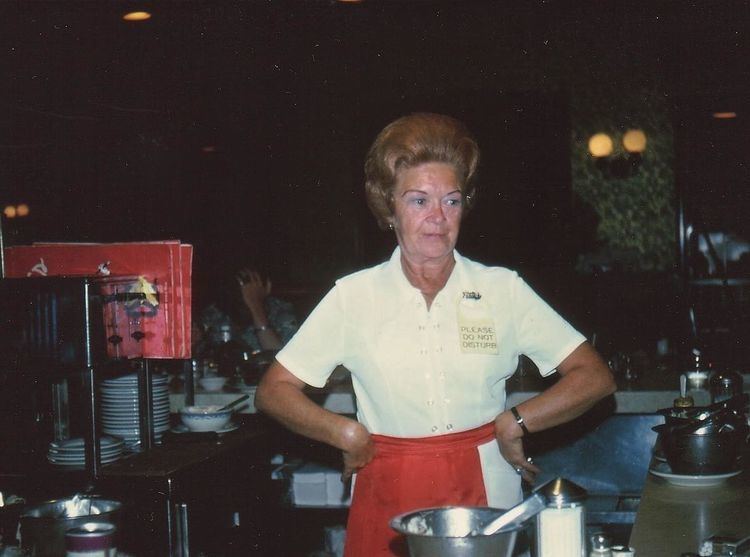 | ||
Waiting staff are those who work at a restaurant or a bar, and sometimes in private homes, attending customers—supplying them with food and drink as requested. A server or waiting staff takes on a very important role in a restaurant which is to always be attentive and accommodating to the guests. Each waiter follows rules and guidelines that are developed by the manager. Wait staff can abide by this rule by completing many different tasks throughout his or her shift. Such as food-running, polishing dishes and silverware, helping bus tables, and restock working stations with needed supplies.
Contents
Waiting on tables is (along with nursing and teaching) part of the service sector, and among the most common occupations in the United States. The Bureau of Labor Statistics estimates that, as of May 2008, there were over 2.2 million persons employed as servers in the U.S.
Many restaurants choose a specific uniform for their wait staff to wear. Waitstaff may receive tips as a minor or major part of their earnings, with customs varying widely from country to country.
Terminology
An individual waiting tables is commonly called a server, waitress (females only), waiter (referring to males or less commonly either gender), member of the wait staff, waitstaff or serving staff server, waitperson, or less commonly the 1980s American neologism waitron. Archaic terms such as serving girl, serving wench, or serving lad are generally used only within their historical context.
Duties
The duties a waiter, wait staff or server partakes in can be tedious, and challenging but are vital to the success of the restaurant. Such duties include, preparing a section of tables before guests sit down (e.g., changing the tablecloth, putting out new utensils, cleaning chairs, etc.), offering cocktails, specialty drinks, wine, beer or other beverages, recommending food options, requesting the chef to make changes in how food is prepared, pre-clearing the tables, and serving food and beverages to customers. In some higher-end restaurants, servers have a good knowledge of the wine list and can recommend food-wine pairings. At more expensive restaurants, servers memorize the ingredient list for the dishes and the manner in which the food is prepared. For example, if the menu lists marinated beef, the customer might ask what the beef is marinated in, for how long, and what cut of beef is used in the dish. Silver service staff are specially trained to serve at banquets or high-end restaurants. These servers follow specific rules and service guidelines which makes it a skilled job. They generally wear black and white with a long, white apron (extending from the waist to ankle).
The head server is in charge of the waiting staff, and is also frequently responsible for assigning seating. The head server must insure that all staff does their duties accordingly. The functions of a head server can overlap to some degree with that of the Maître d'hôtel. Restaurants in North America employ an additional level of waiting staff, known as busboys or busgirls, increasingly referred to as busser or server assistant to clear dirty dishes, set tables, and otherwise assist the waiting staff.
Emotional labour is often required by waiting staff, particularly at many high-class restaurants.
Requirements
Restaurant serving positions require on the job training that would be held by an upper level server in the restaurant. The server will be trained to provide good customer service, learn food items and drinks and maintain a neat and tidy appearance. Working, in a role such as captain, in a top rated restaurant requires disciplined role-playing comparable to a theater performance.
Individuals employed to handle food and beverages in the United States must obtain a food handlers card or permit. Servers that do not have a permit or handlers card can not serve. The server can achieve a permit or handlers card online.
No food certification requirements are needed in Canada. However, to serve alcoholic beverages in Canada servers must undergo their province's online training course within a month of being hired.
Tipping in the U.S.
Different countries maintain different customs regarding tipping, but in the United States, a tip paid in addition to the amount presented on the bill for food and drinks is customary. At most sit-down restaurants, servers and bartenders expect a tip after a patron has paid the check. The minimum legally required hourly wage paid to waiters and waitresses in many U.S. states is lower than the minimum wage employers are required to pay for most other forms of labor in order to account for the tips that form a significant portion of the server's income.
Tips average between 15% and 20% of the bill. 20% is expected for good service, more than 20% is expected for great service, and some patrons tip even more for exceptional service. If the waiter or waitress goes above and beyond to ensure the patron enjoys his/her meal, it is customary to give a higher tip. Some restaurants charge an automatic gratuity for larger parties (usually 6 or more), and the gratuity ranges from 15%-20% depending on the restaurant.
